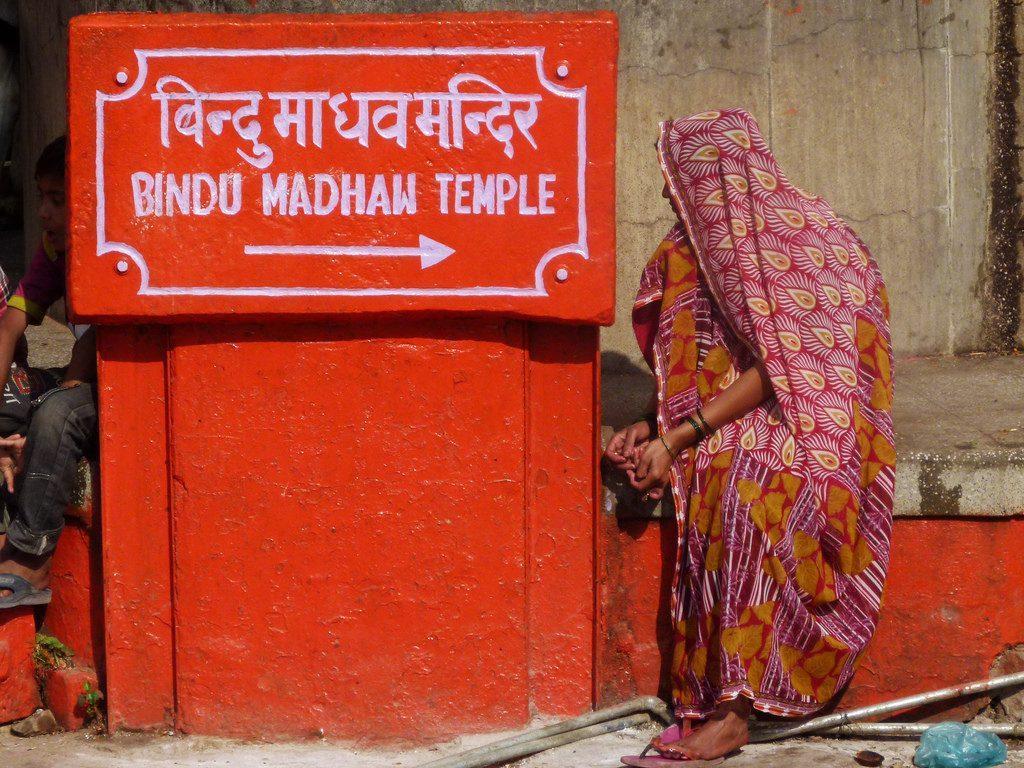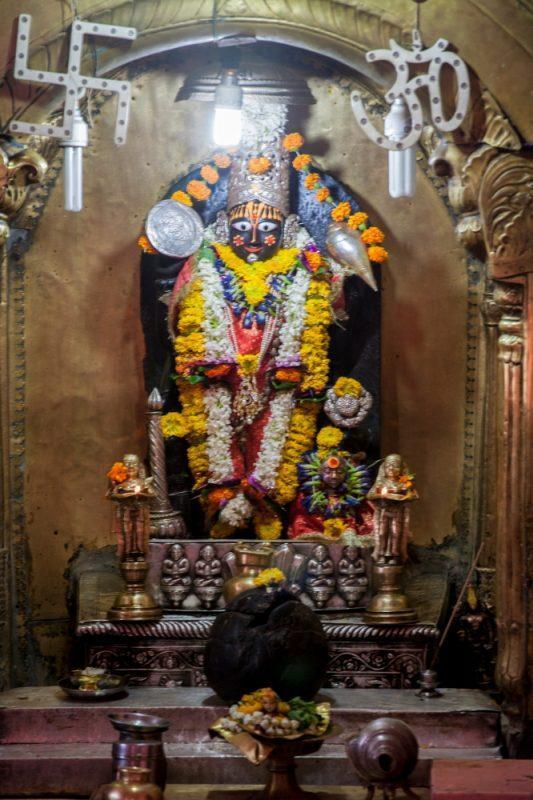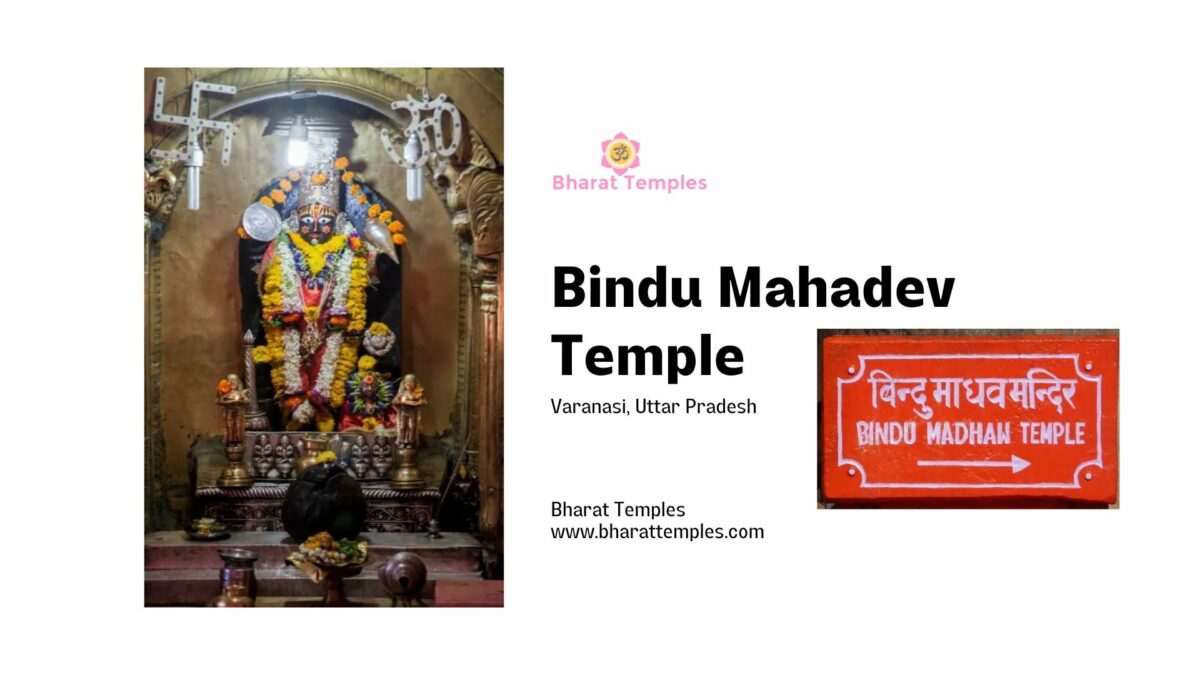Contents
This temple is located near Scindia Ghat at Varanasi.
The temples’s history is relating to 5th century. The temple was demolished by invaders many times since then. The deity was reconsecrated during 16th century by Raja Man Singh. Again in 1682 the temple was demolished.
The present temple built by Raja of Aundh (Satara, Maharashtra) in 19th Century. Large number of devotees visit this temple.

Festivals:
During the Karthika Month, Vaikuntha Chaturdashi is also one among the prominent festivals which marks the event of Lord Vishnu donating Kashi to Lord Shiva. In celebrations, Lord Vishnu offers Bael leaves to Lord Vishwanath and Lord Vishwanath offers tulasi leaves to Lord Bindu Madhav.
The Legend:

As per directions of Lord Shiva, Lord Vishnu travelled from Mandarachal to Kashi with a divine mission of making King Divodas leave Kashi (Kindly read Divodaseshwar)
After having accomplished his mission, Lord Vishnu was enjoying the serene beauty of Kashi, Pancha Nada Teerth, Padodak Teerth and other places. At Pancha Nada Teerth, he came across one extremely lean looking Sage who was undergoing Tapas.
Lord Vishnu in his divine form approached the Sage whose name was Agni Bindu and stood in front of him. The Sage, on seeing the Lord in person, was ecstatic and he prostrated before the Lord. The Sage then started singing praises of the Lord.
The Sage addressed the Lord by various names like Mukunda, Madusudan, Madhav, Narayan, Rama Bhadran, Chatur Bhuj, Janardhan etc. The Sage also mentioned that those who worship Lord Vishnu with Tulsi leaves or garland made of Tulsi Leaves will get lots of blessings.
After having sung all praises about Lord Vishnu, Agni Bindu Rishi stood silently with folded hands. Lord Vishnu asked the Sage to seek any divine boon. The Sage, in reply, sought only one thing: that Lord Vishnu should always be available in the vicinity of Pancha Nada Teerth.
Lord Vishnu granted accordingly. He further stated that Kashi is a Punya Kshetra and devotees can achieve several kinds of Siddhi by staying in Kashi. Lord Vishnu further told that he would stay in Kashi as long as Kashi is present and there will be no destruction of Kashi, as this holy city is situated atop the Trishul (Trident) of Lord Shiva. Therefore, even Maha Pralay (great deluge) cannot destroy the city.
Agni Bindu Rishi was extremely happy at this and sought one more divine boon from Lord Vishnu. He desired that Lord Vishnu should always be available in the vicinity of Pancha Nada Teerth in the name of the Sage. Further, a devotee who takes bath in Pancha Nada Teerth and even if he dies elsewhere, he should attain Moksha. The Sage also sought that a devotee who bathes in Pacha Nada Teerth and worships Lord Vishnu should be blessed with wealth and prosperity.
Lord Vishnu agreed to the request of the Sage. He stated that henceforth he (Lord) will be known as Bindu Madhav in Pancha Nada Teerth. By his presence, the Teerth will be extremely Sacred and devotees who bathe in this Teerth and honour learned persons, will be blessed with wealth and prosperity.
The Teerth, which is capable of cleansing all Sins, will be called as Bindu Teerth. A person may have committed various sins, knowingly or unknowingly. But if, during the Kartik Month, he religiously bathes in Pancha Nada Teerth and worships Bindu Madhav, he will attain Mukti.
Kashi Khand, Chapter 60 has given in detail the importance of Kartik Month in respect to Pancha Nada Teerth. Lord Visweshwar himself regularly takes bath in this Teerth during Kartik Month.
Lord Vishnu further stated that he (Lord) was called as Aadi Madhav in Sat Yug, he should be worshipped as Ananda Madhav in Tretha Yug, he would present himself in Dwapar Yug as Shree Madhav. In Kali Yug the Lord should be known by the name of Bindu Madhav.
Agni Bindu Rishi was extremely happy at the direct worship of Lord Vishnu and he prostrated before the Lord.
History of Bindu Mahadev Temple
Origin of the Temple
According to local legend, the temple was built on the site where Lord Shiva appeared in the form of a bindu (dot) to Mata Parvati. The temple’s construction is attributed to Maharaja Bindu Singh of Jaipur in the 17th century. The temple has undergone several renovations and restorations over the centuries.
Renovation and Restoration
The temple’s current structure is the result of a major renovation that took place in the early 20th century. The renovation was funded by the royal family of Jaipur, who also commissioned the construction of a beautiful garden around the temple.
Architecture of Bindu Mahadev Temple
Exterior Design
The temple’s exterior design is characterized by a blend of Hindu and Islamic architectural styles. The temple’s main entrance is a massive gateway that leads to a courtyard with a central pool. The temple’s main sanctum is located at the center of the pool and is accessed via a small bridge. The temple’s exterior is adorned with intricate carvings and paintings that depict scenes from Hindu mythology.
Interior Design
The temple’s interior is just as impressive as its exterior. The main sanctum is dedicated to Lord Shiva and contains a lingam (phallic symbol) that is said to represent the god. The sanctum’s walls are adorned with paintings and carvings that depict various Hindu gods and goddesses. The temple’s interior also features several smaller shrines dedicated to other deities.
Religious Significance of Bindu Mahadev Temple
The Legend of Lord Shiva and Mata Parvati
According to local legend, Lord Shiva appeared to Mata Parvati in the form of a bindu (dot) while she was performing her daily prayers. The bindu then transformed into a lingam, and Lord Shiva instructed Mata Parvati to build a temple on the site. The temple that was built on the site is now known as Bindu Mahadev Temple.
Festivals and Celebrations
The temple is an important pilgrimage site for followers of Lord Shiva, who come from all over India to pay their respects. The temple also hosts several festivals and celebrations throughout the year, including Mahashivratri, Shravan
How to reach Bindu Madhav Temple
This temple can be reached by two ways. One way is to navigate through the narrow roads of Kashi from the Kala Bhairava Temple which is around 1.5 kms of a walk. The other way is to reach the temple through the Pancha-ganga ghat which one can walk from the other Ghats of Kashi such as Assi Ghat or take a boat ride from the other ghats. There are steep steps to reach the temple ascending from the Pancha-ganga Ghat which is the most magnificent section of the Varanasi riverfront and built by Akbar’s minister Todar Mal in the year 1580.
Directions to the Temple
The temple is located in the heart of Varanasi, just a short distance from the famous Kashi Vishwanath Temple. The nearest airport is the Lal Bahadur Shastri Airport in Varanasi, which is approximately 24 kilometers away from the temple. The temple is also accessible by road and rail, with the Varanasi Railway Station being the closest railway station.
Nearby Attractions
Visitors to Bindu Mahadev Temple can also explore several nearby attractions, including the Kashi Vishwanath Temple, the Sankat Mochan Temple, and the Durga Temple.
Practical Information for Visitors
Visiting Hours
The temple is open to visitors from 5:00 AM to 12:00 PM and from 4:00 PM to 9:00 PM every day.
Dress Code
Visitors are expected to dress modestly and respectfully when visiting the temple. Men are advised to wear full-length pants or trousers, while women are advised to wear saris or salwar kameez.
Entry Fee
There is no entry fee to visit Bindu Mahadev Temple.
Photography
Photography is allowed inside the temple, but visitors are advised to be respectful and not use flash photography.
FAQs
Yes, the main sanctum of the temple is dedicated to Lord Shiva.
No, there is no entry fee to visit the temple.
The temple can be visited year-round, but the best time to visit is during the winter months (October to February) when the weather is cooler.
Yes, visitors can explore several nearby attractions, including the Kashi Vishwanath Temple, the Sankat Mochan Temple, and the Durga Temple.

